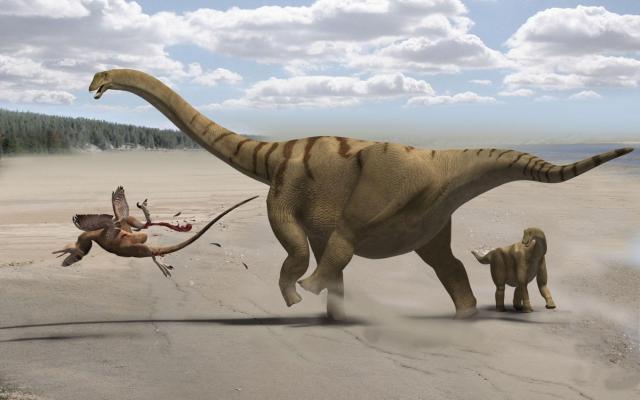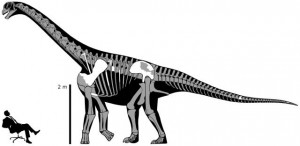Paleontologists Announce “Thunder Thighs”
“Brontosaurus” was a great dinosaur name. The great “thunder reptile” of the Jurassic, there was no better moniker for the stoutly-built sauropod. Unfortunately, the name had to be tossed out in favor of Apatosaurus, but a different dinosaur just described by Michael Taylor, Mathew Wedel and Richa…

"Brontosaurus" was a great dinosaur name. The great "thunder reptile" of the Jurassic, there was no better moniker for the stoutly-built sauropod. Unfortunately, the name had to be tossed out in favor of Apatosaurus, but a different dinosaur just described by Michael Taylor, Mathew Wedel and Richard Cifelli has what I think is an equally awesome name. They have called it Brontomerus--- "thunder thighs."
Discovered during the mid-1990s in the Cedar Mountain Formation of eastern Utah, the fragmentary remains of Brontomerus represent an approximately 112-million-year-old cousin of the better-known Camarasaurus and Brachiosaurus. It is only the latest of several sauropod dinosaurs to be found in the Early Cretaceous rock of North America, confirming that the diversity of sauropods did not catastrophically drop at the end of the Jurassic as paleontologists previously thought. In fact, the authors of the new study note that there are other sauropod dinosaurs from the same formation waiting to be described---we are only just beginning to reconstruct what happened to North American sauropods after the Jurassic.
Frustratingly, our knowledge of Brontomerus is relatively limited. Private collectors had already worked over the quarry which held the dinosaur's skeleton before scientists got to it. Not only did they remove bones, but they also destroyed some. As reported by the authors of the new paper, "Bones left exposed by these previous collectors were in various states of disrepair: some had been broken and their pieces used to hold down the remnants of a plastic tarpaulin."
Despite these difficulties, though, the available material was enough to allow Taylor, Wedel and Cifelli to recognize the unique nature of Brontomerus. The most distinctive bone is the upper part of the hip---an ilium---from a juvenile animal, and this bone has an expansion called the preacetabular lobe that is much taller and larger than what is seen in other sauropods. In life, this wing of bone would have been the site of massive muscle attachments, giving the back legs of Brontomerus a beefy look that inspired its "thunder thighs" name.

Just why Brontomerus had so much extra space for muscle is a mystery. Taylor, Wedel and Cifelli offer three possibilities. Maybe Brontomerus had relatively longer legs than other sauropods, and so would require larger upper leg muscles. Then again, maybe the muscles would have made it easier for this dinosaur to rear up on its hind limbs, and perhaps this dinosaur could have walked on its hind legs for short periods of time. As depicted by Francisco Gascó in what is now one of my favorite dinosaur restorations ever, though, the big muscles of Brontomerus may have given it a formidable kick. Utahraptor lived about 12 million years before Brontomerus, but, if the two ever met, the sauropod had the muscle power to punt the feathery predator as it does in Gascó's wonderful illustration.
The hip was not the only sauropod fossil to be found in the quarry. Additional skeletal elements include parts of several vertebrae, a rib, sternal plates and a shoulder blade from an adult. Whether all of these bones should be assigned to Brontomerus will require more complete skeletons to confirm, but for now, it is reasonable to hypothesize that the fossils found so far represent an adult and a juvenile. Even then, much of this dinosaur's skeleton remains unknown, and paleontologists will have to keep digging to figure out what Brontomerus looked like and how it lived.
For more on Brontomerus, visit SV-POW! and see this post by study author Mike Taylor. Additional posts about the dinosaur will be added at SV-POW! in the near future.
References:
Taylor, M.; Wedel, M.; Cifelli, R. (2011). Brontomerus mcintoshi, a new sauropod dinosaur from the Lower Cretaceous Cedar Mountain Formation, Utah, USA Acta Palaeontologica Polonica DOI: 10.4202/app.2010.0073
/https://tf-cmsv2-smithsonianmag-media.s3.amazonaws.com/accounts/headshot/RileyBlack.png)
/https://tf-cmsv2-smithsonianmag-media.s3.amazonaws.com/accounts/headshot/RileyBlack.png)